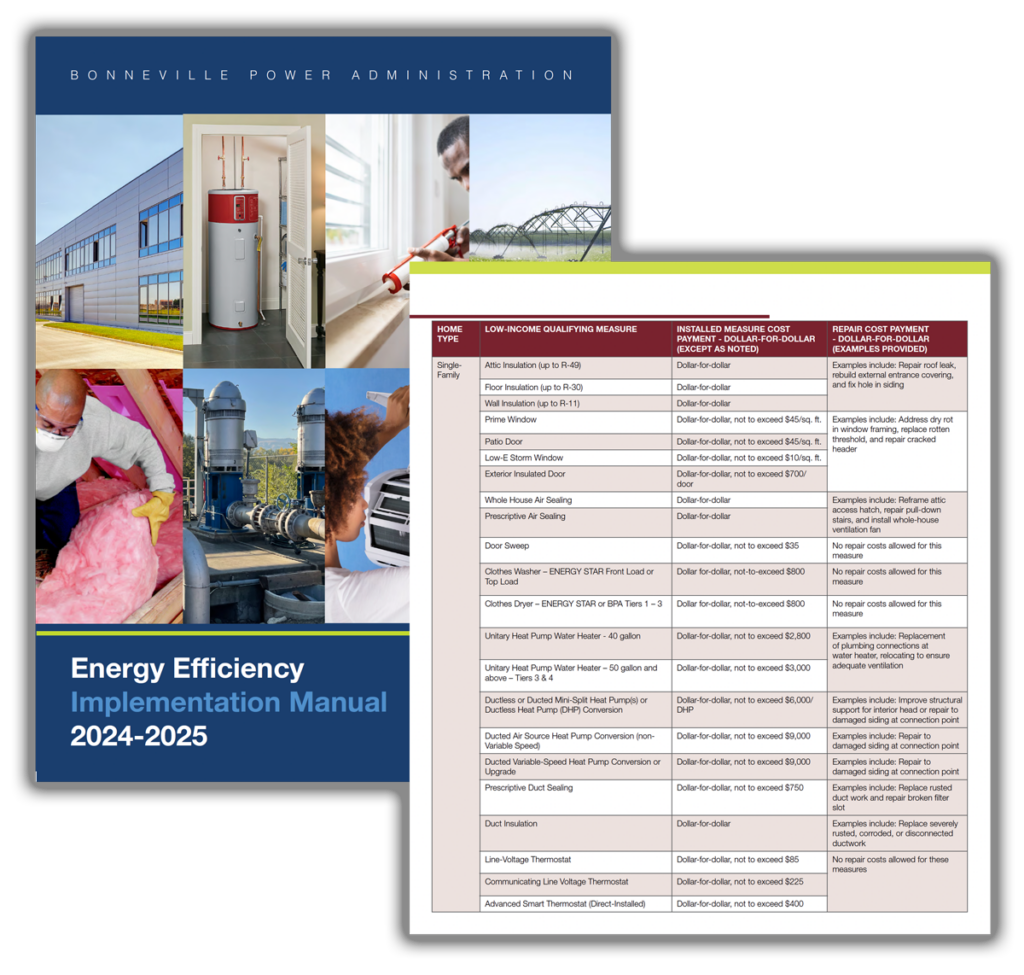Plan and Manage a Program for Low-Income Customers
Resources to help you establish an efficient, effective and user-friendly utility program.
Income-qualified programs are an essential part of a utility’s service to their customers and provide many benefits beyond simple energy savings. If you are part of a utility wanting to launch a new low-income program or improve an existing process, this guide will help you determine where to begin and what to expect.
What’s the same as a standard program?
- All technical requirements
- All pre-qualification and efficiency requirements
- Most of the documentation and BEETS reporting requirements
What’s different for low-income?
- Higher incentive values
- Eligibility of funds for repair costs
- Income qualification verification
- Potential partnerships with Community Action Agencies
For detailed measure information, see the current BPA Energy Efficiency Implementation Manual (IM) or contact your Energy Efficiency Representative (EER).
For more information and assistance around low-income programs, review the BPA Energy Efficiency Low-Income New Opportunities Guide.
Considerations to Take When Developing Your Program
Determine a Budget
Determine how much of your available Energy Efficiency Incentive (EEI) budget and staff resources can be dedicated to a low-income program.
EEI funding covers:
Incentives:
BPA offers significantly higher incentive amounts for low-income measures in comparison to its other programs. Many installation costs are fully reimbursed by BPA.
BPA’s incentives help cover costs associated with meeting requirements and specifications, such as verification of income, attic and crawl space ventilation, removal of knob-and-tube wiring, and underfloor moisture barriers. See the BPA Implementation Manual for the current list of measures that are eligible for reimbursement in Single-Family, Multifamily and manufactured homes.
Repair Costs:
EEI funding can cover costs of repair work associated with the installation if it is required to ensure the effectiveness of the measure. Examples include replacing rotting wood in a window frame or repairing a hole in the roof.
Staff Resource Considerations:
Consider the number of utility staff and contractors needed to administer the program, which may include screening applicants and verifying income. Northwest utilities that manage active, low-income programs in-house generally have at least one staff member and a network of contractors with sufficient capacity and training.
If your utility does not currently have sufficient in-house resources, consider opportunities to partner with a Community Action Agency (CAA). EEI funds can be paid to CAAs when IM measure qualifications are followed.
Need help finding a knowledgeable contractor for your territory? Contact your Comfort Ready Home Field Specialist.
Income Verification
Whether you are screening applicants, verifying income in-house, or working with a CAA, it is important to understand the documentation that utilities are required to review and approve to qualify residents for incentives. As of October 1, 2023, there are two options for verifying income for LIEE customers: documented income verification or self-attestation of income. See below for further details on these two options.
Option 1: Documented Income Verification
Formal income verification is one means of verifying customers’ income. Utilities may choose to go this route:
Review any of the following information to verify income. You are not required to retain these items in your project files or provide them to BPA during oversight.
- ✓ Total number of individuals in the household
- ✓ Home type (single, multi or manufactured)
- ✓ Primary heating type (in most cases)
- ✓ Verification that household income is at or below 200% of the HHS Poverty Guidelines or meets approved statewide or tribal eligibility definitions. Any of the following documentation is acceptable:
- Certification by a Community Action Agency
- A copy of filed Form 1040 (Individual Income Tax Return)
- Paystubs
- Section 8 Housing Choice Voucher eligibility
- Certification by a Low-Income Home Energy Assistance Program (LIHEAP) administrator (Note that LIHEAP bill payments can be identified on most utility bills and a screenshot of the payment and date can be used as proof of qualification.)
- Proof of current assistance from a state health and human services agency
- Current Temporary Assistance for Needy Families (TANF) benefits
- Supplemental Security Income (SSI)
- HUD Certification
Option 2: Self-Attestation
As of October 1, 2023, BPA allows utility customers to accept a signed self-attestation of income status to qualify for low-income incentives. Utilities are not required to provide the income level to BPA during oversight, just that they have been reviewed and approved.
For self-attestation, utilities can use the Low-Income Project Information Form and Income Verification Form (Optional) or draft your own version. Contact your Field Specialist for assistance creating a customized form.
Work with a Community Action Agency

Community Action Agencies (CAAs), often referred to as Community Action Programs (CAPs), are organizations that provide low-income households with direct support, such as, implementing a range of energy efficiency measures and energy assistance. Utilities often partner with CAAs on low-income programs, since many CAAs are already equipped to handle:
- Applicant screening
- Income verification
- Energy assistance
- Project management for energy efficiency installations, including weatherization, HVAC, water heating, lighting, appliances, and others
- Bundling together additional local, state, and federal funding sources
- Recruiting and working with in-house or local contractors
CAAs in your territory may have a long waitlist. Even if you’re not certain about partnering with an agency, it may be a good idea to reach out to learn more and discuss:
- Capacity to implement increased funding from your utility EEI budget
- Current wait times for auditing and addressing homes
- Ability to work on homes requiring significant repairs before energy-efficiency work can be done
- Technical and documentation requirements for measures
- Additional fees and implementation costs
To find nearby agencies, use the Community Action Partnership’s locator tool. Your Comfort Ready Home Field Specialist can also help you find and coordinate with a local CAA.
For in-depth guidance on building a relationship with a CAA and creating an agreement, refer to BPA’s Low-Income New Opportunities Guide.
Measures and Incentives
The BPA Implementation Manual (IM) includes the current list of measures that are eligible for reimbursement in single family, multifamily and manufactured homes. Most reimbursements are paid at dollar-for-dollar amounts and some have not-to-exceed limits. The IM includes all of the installation specifications, technical qualifications, qualified products lists, contractor requirements, forms, and other measure details for the individual measures.

Marketing and Outreach
Creating awareness of your low-income program is important. To ensure that your low-income program is serving its target audience, consider the following tactics to spread the word:
- Prioritize outreach to households in your territory that have expressed the need for support, including high energy-use homes, customers experiencing shut-offs, or seniors that have requested direct bill assistance.
- Research households in your area who qualify for LIHEAP, HUD, NAHASDA or other federal programs.
- Develop a form to capture all necessary data or customize this Low-Income Project Information Form and Income Verification Form (Optional) for your program.
- Create a simple and recognizable name for your program.
- Dedicate a simple page on your website to the program that is focused on the benefits for participants. Avoid unnecessary jargon and include a clear call-to-action.
- Advertise on social media to increase reach to households in your area. A small budget can lead to thousands of impressions and many visits to your website.
- Create marketing collateral such as bill stuffers and flyers with QR codes that can be distributed in-person at events.
- Create multi-lingual content to increase accessibility to your program.
For marketing assistance and to use existing materials or customize your own, reach out to your Comfort Ready Home Field Specialist. Check out the Comfort Ready Home Utility Marketing Toolkit for additional resources.
Reporting and Documentation
For low-income work, BPA documentation requirements are not much different from non-low-income energy efficiency projects. The primary differences are income qualification and reporting requirements for low-income repair costs.
For reporting, you can customize this Low-Income Project Information Form and Income Verification Form (Optional) for your program or build your own to help implement your program. Note that BPA does not require this specific form to be submitted or kept on file.
Below is an example of what information utilities, CAAs, and BPA collect and retain on file. For more details, reference the current Implementation Manual.
INFORMATION COLLECTED BY UTILITY:Submits to BPA:
Required to maintain on file at the utility and may be requested during oversight:
|
INFORMATION COLLECTED BY IMPLEMENTING AGENCY OR CAA:Submits to Utility and kept on file:
These are only examples of documents that some utilities require from CAAs for their own program implementation for information only, but they are not required to be submitted per BPA:
|
For more information about reporting low-income projects in BEETS, please contact your utility Energy Efficiency Representative (EER) or COTR.
Engage Multicultural Audiences
As the Northwest becomes more diverse, it’s more important than ever to engage with multicultural audiences — especially those with language barriers. Latinos, for example, are a culturally rich and value-driven audience that comprises a large share of the region’s population. An effective low-income program should account for this in its marketing and outreach strategy.
Examples include:
- Creating marketing materials, collateral and website content in Spanish
- Providing a Spanish version of the enrollment application and instructions
- Partnering with a Latino community organization for outreach, such as Latino Network and Latino Community Association (Oregon), CIELO and Mi Centro (Washington) and the Community Council of Idaho
- Noting which households are primarily Spanish-speaking and, whenever possible, working with your contractor network or CAA to provide Spanish-speaking contractors and assistance. Many CAAs offer support and materials in Spanish for limited English proficiency (LEP) clients.
- Consider other multicultural organizations for support as well, including APANO
For assistance with multicultural marketing, outreach, and translation, or in finding a Spanish-speaking contractor in your territory, contact your Comfort Ready Home Field Specialist. Have an organization you would like us to list? Contact us.
Low-Income Support Available through Comfort Ready Home
Your Field Specialist can support you with a number of tools for your low-income program:
- ✓ Finding a qualified contractor to offer installation and paperwork support for low-income projects
- ✓ Coordinating with your local CAA to support your projects
- ✓ Building Spanish-language materials for your program
- ✓ Creating forms or marketing materials for your program
- ✓ Customizing the Low-Income Project Information Form and Income Verification Form (Optional)
- ✓ Finding additional resources such as grants or financing programs that might help your program
- ✓ Multifamily custom project support
- ✓ Community event support
Direct-Line Resources
If you have questions or need help with your low-income program, the following BPA and Comfort Ready Home resources can provide direct support:
- Your Energy Efficiency Representative (EER)
- Email BPA Staff
- Your Comfort Ready Home Field Specialist